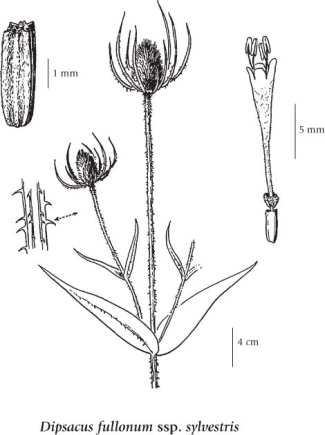Dipsacus fullonum subsp. sylvestris (Huds.) Clapham
Fuller's teasel
Dipsacaceae (Teasel family)
Introduction to Vascular Plants
Fuller's teasel
Dipsacaceae (Teasel family)
Introduction to Vascular Plants
Photograph
© Diane Williamson (Photo ID #14223)
Map
Distribution of Dipsacus fullonum subsp. sylvestris
Click here to view the full interactive map and legend
Introduction
Teasel was introduced to North America (upper New York first, then Oregon) in the mid nineteenth century as a crop for the fabric industry where the flower heads were used to 'brush' woolen fabrics to bring up the nap (Wildflowers of the Southeastern United States 2002). It is now found naturalized in most US states and in three Canadian provinces (BC, ON, QC) (USDA 2010). In Canada, it was first collected in 1877 at Niagara Falls in Ontario (Werner 1979). The earliest collection record for British Columbia in the UBC Herbarium is from 1923, when it was collected by Ashlee in Hastings Park in Vancouver.
|
Species Information
General:
Biennial herb from a taproot; stems erect, stout, angled, few-branched, increasingly prickly upwards, 0.5-2.0 m tall.
Leaves:
Basal leaves oblanceolate, toothed, in rosettes; stem leaves lanceolate, opposite, simple, more or less prickly, especially on the midrib, otherwise glabrous, the pairs usually only shallowly fused around the stem, toothed below, becoming entire upwards, up to 50 cm long.
Flowers:
Inflorescence of 3-10, egg-shaped to nearly cylindrical heads, terminating long naked stalks, the heads persisting through winter; corollas lavender, rarely white, funnel-shaped, shallowly 4-lobed, hairy, 10-15 mm long; calyces cuplike, 1 mm long, 4-angled or 4-lobed, silky; involucral bracts unequal, more or less prickly, linear, stiff, curved upwards, the longer ones surpassing the heads; receptacles scaly, these ending in spines.
Fruits:
Achenes, 5-8 mm long, 4-angled, hairy.
Illustration

If more than one illustration is available for a species (e.g., separate illustrations were provided for two subspecies) then links to the separate images will be provided below. Note that individual subspecies or varietal illustrations are not always available.
Illustration Source: The Illustrated Flora of British Columbia
Habitat and Range
Moist fields, meadows and roadsides in the lowland zone; rare in SW and SC BC; introduced from Eurasia.Status Information
Synonyms
Synonyms and Alternate Names:
Dipsacus sylvestris Huds.
Taxonomic Notes
This plant is frequently used in dried flower arrangements.
|
References
Werner, Patricia A. 1979. Dipsacus sylvestris Huds. In: Mulligan, Gerald A. The Biology of Canadian Weeds. Biosystematics Research Institute, Ottawa.